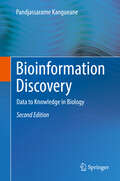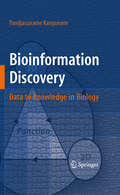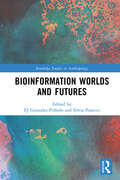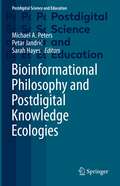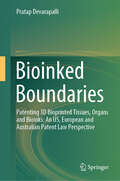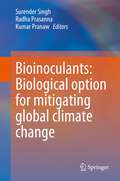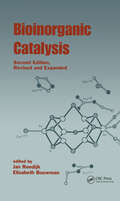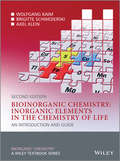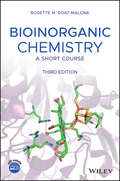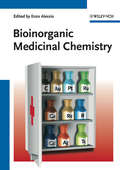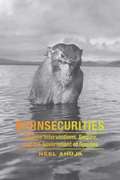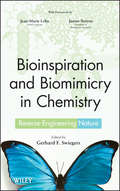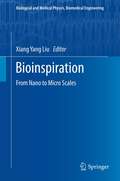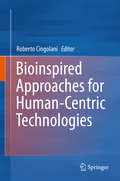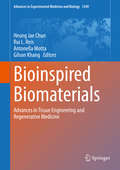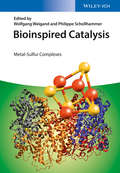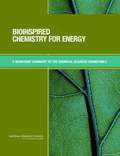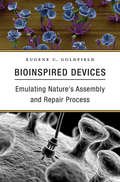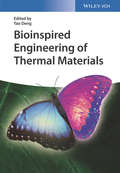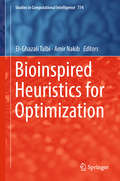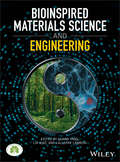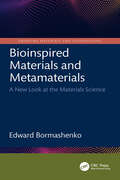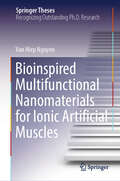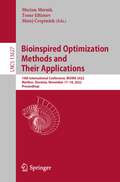- Table View
- List View
Bioinformation Discovery: Data to Knowledge in Biology
by Pandjassarame KangueaneThis new edition continues to illustrate the power of biological data in knowledge discovery. It describes biological data types and representations with examples for creating a workflow in bioinformation discovery. The concepts in knowledge discovery from data are illustrated using line diagrams. The principles and concepts in knowledge discovery are used for the development of prediction models for simulations of biological reactions and events. Advanced topics in molecular evolution and cellular & molecular biology are addressed using bioinformation gleaned through discovery. Each chapter contains approximately 10 exercises for practice. This will help students to expand their problem solving skills in Bioinformation Discovery. In this new edition, there are three new chapters covering single nucleotide polymorphism, genes, proteins and disease, and protein functions driven by surface electrostatics.
Bioinformation Discovery: Data to Knowledge in Biology
by Pandjassarame KangueaneBioinformation Discovery illustrates the power of biological data in knowledge discovery. It describes biological data types and representations with examples for creating a workflow in Bioinformation discovery. The concepts in knowledge discovery from data are illustrated using line diagrams. The principles and concepts in knowledge discovery are used for the development of prediction models for simulations of biological reactions and events. Advanced topics in molecular evolution and cellular & molecular biology are addressed using Bioinformation gleaned through discovery. Each chapter contains approximately 10 exercises for practice. This will help students to expand their problem solving skills in Bioinformation Discovery. Each chapter concludes with a number of good problem sets to test mastery of the material.
Bioinformation Worlds and Futures (Routledge Studies in Anthropology)
by Ej Gonzalez-PolledoThis book sets out to define and consolidate the field of bioinformation studies in its transnational and global dimensions, drawing on debates in science and technology studies, anthropology and sociology. It provides situated analyses of bioinformation journeys across domains and spheres of interpretation. As unprecedented amounts of data relating to biological processes and lives are collected, aggregated, traded and exchanged, infrastructural systems and machine learners produce real consequences as they turn indeterminate data into actionable decisions for states, companies, scientific researchers and consumers. Bioinformation accrues multiple values as it transverses multiple registers and domains, and as it is transformed from bodies to becoming a subject of analysis tied to particular social relations, promises, desires and futures. The volume harnesses the anthropological sensibility for situated, fine-grained, ethnographically grounded analysis to develop an interdisciplinary dialogue on the conceptual, political, social and ethical dimensions posed by bioinformation.
Bioinformational Philosophy and Postdigital Knowledge Ecologies (Postdigital Science and Education)
by Sarah Hayes Michael A. Peters Petar JandrićThe book presents a cross-disciplinary overview of critical issues at the intersections of biology, information, and society. Based on theories of bioinformationalism, viral modernity, the postdigital condition, and others, this book explores two inter-related questions: Which new knowledge ecologies are emerging? Which philosophies and research approaches do they require? The book argues that the 20th century focus on machinery needs to be replaced, at least partially, by a focus on a better understanding of living systems and their interactions with technology at all scales – from viruses, through to human beings, to the Earth’s ecosystem. This change of direction cannot be made by a simple relocation of focus and/or funding from one discipline to another. In our age of the Anthropocene, (human and planetary) biology cannot be thought of without (digital) technology and society. Today’s curious bioinformational mix of blurred and messy relationships between physics and biology, old and new media, humanism and posthumanism, knowledge capitalism and bio-informational capitalism defines the postdigital condition and creates new knowledge ecologies. The book presents scholarly research defining new knowledge ecologies built upon emerging forms of scientific communication, big data deluge, and opacity of algorithmic operations. Many of these developments can be approached using the concept of viral modernity, which applies to viral technologies, codes and ecosystems in information, publishing, education, and emerging knowledge (journal) systems. It is within these overlapping theories and contexts, that this book explores new bioinformational philosophies and postdigital knowledge ecologies.
Bioinked Boundaries: Patenting 3D Bioprinted Tissues, Organs and Bioinks: An US, European and Australian Patent Law Perspective
by Pratap DevarapalliThis book presents a comprehensive and comparative study of the patentability of bioprinting inventions, specifically bioinks and bioprinted tissues, in the US, the Europe and Australia. It employs a two-phase analysis to understand, ‘Is the patentable subject matter requirement a hurdle to patenting bioprinting inventions, specifically bioinks and bioprinted tissues?’ The first phase is a doctrinal analysis of the patent laws and jurisprudence in respective jurisdictions, highlighting the similarities and differences in their approaches to the subject matter requirement. The second phase is an empirical analysis of the patent prosecution data from patent applications filed in each jurisdiction with claims directed towards bioprinted tissues and bioinks, revealing how patent examiners apply the patent provisions to accept or object to such patent claims. The book offers several contributions to the field of bioprinting and patent law. First, it provides a detailed and up-to-date overview of the current state of the art and the legal landscape of bioprinting inventions. Second, it identifies the main criteria and factors that patent examiners use to assess the patentable subject matter of bioprinted tissues and bioinks, such as the level of human intervention, the markedly different characteristics, and the industrial applicability. Third, it proposes patenting framework models for each jurisdiction, which can assist patent applicants to draft and amend their patent claims in accordance with the patentable subject matter requirement. Fourth, it evaluates the potential benefits and implications of patenting bioprinting inventions for the bioprinting industry and society at large, such as fostering innovation, promoting public health, and indirectly addressing ethical and social issues. The main benefit that the reader will derive from the book is a deeper understanding of the patentability of bioprinting inventions, specifically bioinks and bioprinted tissues, in different jurisdictions and contexts. The book will help the reader to appreciate the legal and technical aspects of bioprinting and patent law, and how they affect the bioprinting industry and society at large.
Bioinoculants: Biological Option for Mitigating global Climate Change
by Surender Singh Radha Prasanna Kumar PranawThis edited book covers various bioinoculants for sustainable crop production under the changing global climate. The book envisages a compilation of articles relevant to the current status of production and use of novel microbial inoculants for different crops and highlights their role in mitigating global climate challenges. These include nutrient deficiencies, salinity, drought, and emerging pathogens. In addition, success stories and commercialization aspects are also discussed. Growing environmental concerns related to climate change can potentially decrease the global yield capacity of agricultural systems. Agricultural productivity is severely affected by major biotic and abiotic factors. The phytomicrobiome plays a critical role in the survival of the holobiont, particularly for plants growing in extreme environments. The use of microbial-based agricultural inputs has a long history, beginning with a broad-scale rhizobial inoculation of legumes in the early twentieth century. Microbial inoculants are considered one of the best and most effective strategies for sustainable agriculture under climate change, and a viable solution to meet the twin challenges of global food security and environmental sustainability. It is therefore imperative to understand the current status and development in the area of bioinoculants from a global perspective. The chapter’s focus would be on major agro-ecologies, covering all major crops across the globe, along with the commercialization status of different bioinoculants in different countries The book caters to the needs of the students, faculty, policymakers, and researchers working in the area of microbiology, biotechnology, environmental sciences, and botany.
Bioinorganic Catalysis
by Jan Reedijk Elisabeth Bouwman"Provides the latest research results and suggests new topics for interdisciplinary study of metal ions, catalysis, and biochemical systems. Second Edition highlights potential applications; includes new chapters on zinc and FeS clusters; presents new X-ray analysis of metalloenzymes; and more."
Bioinorganic Chemistry -- Inorganic Elements in the Chemistry of Life
by Brigitte Schwederski Axel Klein Wolfgang KaimThe field of Bioinorganic Chemistry has grown significantly in recent years; now one of the major sub-disciplines of Inorganic Chemistry, it has also pervaded other areas of the life sciences due to its highly interdisciplinary nature.Bioinorganic Chemistry: Inorganic Elements in the Chemistry of Life, Second Edition provides a detailed introduction to the role of inorganic elements in biology, taking a systematic element-by-element approach to the topic. The second edition of this classic text has been fully revised and updated to include new structure information, emerging developments in the field, and an increased focus on medical applications of inorganic compounds. New topics have been added including materials aspects of bioinorganic chemistry, elemental cycles, bioorganometallic chemistry, medical imaging and therapeutic advances.Topics covered include:Metals at the center of photosynthesisUptake, transport, and storage of essential elementsCatalysis through hemoproteinsBiological functions of molybdenum, tungsten, vanadium and chromiumFunction and transport of alkaline and alkaline earth metal cationsBiomineralizationBiological functions of the non-metallic inorganic elementsBioinorganic chemistry of toxic metalsBiochemical behavior of radionuclides and medical imaging using inorganic compoundsChemotherapy involving non-essential elements This full color text provides a concise and comprehensive review of bioinorganic chemistry for advanced students of chemistry, biochemistry, biology, medicine and environmental science.
Bioinorganic Chemistry: A Short Course
by Rosette M. Roat-MaloneIntroduces students to the basics of bioinorganic chemistry This book provides the fundamentals for inorganic chemistry and biochemistry relevant to understanding bioinorganic topics. It provides essential background material, followed by detailed information on selected topics, to give readers the background, tools, and skills they need to research and study bioinorganic topics of interest to them. To reflect current practices and needs, instrumental methods and techniques are referred to and mixed in throughout the book. Bioinorganic Chemistry: A Short Course, Third Edition begins with a chapter on Inorganic Chemistry and Biochemistry Essentials. It then continues with chapters on: Computer Hardware, Software, and Computational Chemistry Methods; Important Metal Centers in Proteins; Myoglobins, Hemoglobins, Superoxide Dismutases, Nitrogenases, Hydrogenases, Carbonic Anhydrases, and Nitrogen Cycle Enzymes. The book concludes with chapters on Nanobioinorganic Chemistry and Metals in Medicine. Readers are also offered end-of-section summaries, conclusions, and thought problems. Reduces size of the text from previous edition to match the first, keeping it appropriate for a one-semester course Offers primers and background materials to help students feel comfortable with research-level bioinorganic chemistry Emphasizes select and diverse topics using extensive references from current scientific literature, with more emphasis on molecular biology in the biochemistry section, leading to a discussion of CRISPR technology Adds new chapters on hydrogenases, carbonic anhydrases, and nitrogen cycle enzymes, along with a separate chapter on nanobioinorganic chemistry Features expanded coverage of computer hardware and software, metalloenzymes, and metals in medicines Supplemented with a companion website for students and instructors featuring Powerpoint and JPEG figures and tables, arranged by chapter Appropriate for one-semester bioinorganic chemistry courses, Bioinorganic Chemistry: A Short Course, Third Edition is ideal for upper-level undergraduate and beginning graduate students. It is also a valuable reference for practitioners and researchers in need of a general introduction to the subject, as well as chemists requiring an accessible reference.
Bioinorganic Medicinal Chemistry
by Enzo AlessioThis book gives a comprehensive overview about medicinal inorganic chemistry. Topics like targeting strategies, mechanism of action, Pt-based antitumor drugs, radiopharmaceuticals are covered in detail and offer the reader an in-depth overview about this important topic.
Bioinsecurities: Disease Interventions, Empire, and the Government of Species
by Neel AhujaIn Bioinsecurities Neel Ahuja argues that U.S. imperial expansion has been shaped by the attempts of health and military officials to control the interactions of humans, animals, viruses, and bacteria at the borders of U.S. influence, a phenomenon called the government of species. The book explores efforts to control the spread of Hansen's disease, venereal disease, polio, smallpox, and HIV through interventions linking the continental United States to Hawai'i, Panamá, Puerto Rico, Cuba, Congo, Iraq, and India in the twentieth and twenty-first centuries. Ahuja argues that racial fears of contagion helped to produce public optimism concerning state uses of pharmaceuticals, medical experimentation, military intervention, and incarceration to regulate the immune capacities of the body. In the process, the security state made the biological structures of human and animal populations into sites of struggle in the politics of empire, unleashing new patient activisms and forms of resistance to medical and military authority across the increasingly global sphere of U.S. influence.
Bioinspiration and Biomimicry in Chemistry
by Janine Benyus Jean-Marie Lehn Gerhard SwiegersCan we emulate nature's technology in chemistry?Through billions of years of evolution, Nature has generated some remarkable systems and substances that have made life on earth what it is today. Increasingly, scientists are seeking to mimic Nature's systems and processes in the lab in order to harness the power of Nature for the benefit of society.Bioinspiration and Biomimicry in Chemistry explores the chemistry of Nature and how we can replicate what Nature does in abiological settings. Specifically, the book focuses on wholly artificial, man-made systems that employ or are inspired by principles of Nature, but which do not use materials of biological origin.Beginning with a general overview of the concept of bioinspiration and biomimicry in chemistry, the book tackles such topics as:Bioinspired molecular machinesBioinspired catalysisBiomimetic amphiphiles and vesiclesBiomimetic principles in macromolecular scienceBiomimetic cavities and bioinspired receptorsBiomimicry in organic synthesisWritten by a team of leading international experts, the contributed chapters collectively lay the groundwork for a new generation of environmentally friendly and sustainable materials, pharmaceuticals, and technologies. Readers will discover the latest advances in our ability to replicate natural systems and materials as well as the many impediments that remain, proving how much we still need to learn about how Nature works.Bioinspiration and Biomimicry in Chemistry is recommended for students and researchers in all realms of chemistry. Addressing how scientists are working to reverse engineer Nature in all areas of chemical research, the book is designed to stimulate new discussion and research in this exciting and promising field.
Bioinspiration: From Nano to Micro Scales (Biological and Medical Physics, Biomedical Engineering)
by Xiang Yang LiuMethods in bioinspiration and biomimicking have been around for a long time. However, due to current advances in modern physical, biological sciences, and technologies, our understanding of the methods have evolved to a new level. This is due not only to the identification of mysterious and fascinating phenomena but also to the understandings of the correlation between the structural factors and the performance based on the latest theoretical, modeling, and experimental technologies. Bioinspiration: From Nano to Micro Scale provides readers with a broad view of the frontiers of research in the area of bioinspiration from the nano to macroscopic scales, particularly in the areas of biomineralization, antifreeze protein, and antifreeze effect. It also covers such methods as the lotus effect and superhydrophobicity, structural colors in animal kingdom and beyond, as well as behavior in ion channels. A number of international experts in related fields have contributed to this book, which offers a comprehensive and synergistic look into challenging issues such as theoretical modeling, advanced surface probing, and fabrication. The book also provides a link to the engineering of novel advanced materials playing an important role in advancing technologies in various fields.
Bioinspired Actuators and Sensors
by Elizabeth Minoru Taya Van Volkenburgh Makoto Mizunami Shûhei NomuraFrom authors renowned in the fields of engineering and biology, this is the first book to integrate sensor and actuator technology with bioinspired design. Beginning with detailed descriptions of actuation and sensing mechanisms in plants and animals, the authors move on to apply these principles to synthetic design, offering in-depth knowledge of the development of state-of-the-art smart materials and devices. All of this is supported with a range of real-world applications, from tactile sensory systems in insects linked with the development of robotic hands, to the structural colour systems in nature used to inspire camouflage technology. Further examples are given of successful designs along with their integrated autonomous systems, such as flying and swimming, unmanned systems, and autonomous zero-energy building design. With a wide interdisciplinary appeal, this is an ideal resource for any student, practising engineer, or researcher interested in the connection between natural systems and synthetic design.
Bioinspired Approaches for Human-Centric Technologies
by Roberto CingolaniThe present book discusses topics related to research and development of materials and devices at nanoscale size and their respective application in medicine and biomedicine. The individual chapters give a detailed state of the art overview to the distinct topic. Apparently disconnected fields - life sciences, biomedicine, chemistry, physics, medicine and engineering - will be bridged with a highly interdisciplinary view onto each subject.
Bioinspired Biomaterials: Advances in Tissue Engineering and Regenerative Medicine (Advances in Experimental Medicine and Biology #1249)
by Rui L. Reis Heung Jae Chun Gilson Khang Antonella MottaThis book is the first of two volumes that together offer a comprehensive account of cutting-edge advances in the development of biomaterials for use within tissue engineering and regenerative medicine. Topics addressed in this volume, which is devoted to bioinspired biomaterials, range from novel biomaterials for regenerative medicine through to emerging enabling technologies with applications in, for example, drug delivery, maternal–fetal medicine, peripheral nerve repair and regeneration, and brain tumor therapy. New bioinspired hydrogels receive detailed attention in the book, and a further focus is the use of bioinspired biomaterials in the regulation of stem cell fate. Here the coverage includes the role of scaffolds in cartilage regeneration, the bioapplication of inorganic nanomaterials in tissue engineering, and guidance of cell migration to improve tissue regeneration. The authors are recognized experts in the interdisciplinary field of regenerative medicine and the book will be of value for all with an interest in regenerative medicine based on biomaterials.
Bioinspired Catalysis
by Wolfgang Weigand Philippe SchollhammerThe growing interest in green chemistry calls for new, efficient and cheap catalysts. Living organisms contain a wide range of remarkably powerful enzymes, which can be imitated by chemists in the search for new catalysts. In bioinspired catalysis, chemists use the basic principles of biological enzymes when creating new catalyst analogues. In this book, an international group of experts cover the topic from theoretical aspects to applications by including a wide variety of examples of different systems. This valuable overview of bioinspired metal-sulfur catalysis is a must-have for all scientists working in this hot field, including PhD students, postdocs and researchers.
Bioinspired Chemistry For Energy: A Workshop Summary To The Chemical Sciences Roundtable
by National Research Council of the National AcademiesFaced with the steady rise in energy costs, dwindling fossil fuel supplies, and the need to maintain a healthy environment - exploration of alternative energy sources is essential for meeting energy needs. Biological systems employ a variety of efficient ways to collect, store, use, and produce energy. By understanding the basic processes of biological models, scientists may be able to create systems that mimic biomolecules and produce energy in an efficient and cost effective manner. On May 14-15, 2007 a group of chemists, chemical engineers, and others from academia, government, and industry participated in a workshop sponsored by the Chemical Sciences Roundtable to explore how bioinspired chemistry can help solve some of the important energy issues the world faces today. The workshop featured presentations and discussions on the current energy challenges and how to address them, with emphasis on both the fundamental aspects and the robust implementation of bioinspired chemistry for energy.
Bioinspired Devices: Emulating Nature’s Assembly and Repair Process
by Eugene C. GoldfieldEugene Goldfield lays out principles of engineering found in the natural world, with a focus on how components of coordinated structures organize themselves into autonomous functional systems. This self-organizing capacity is one of many qualities which can be harnessed to design technologies that can interact seamlessly with human bodies.
Bioinspired Engineering of Thermal Materials
by Tao DengA comprehensive overview and summary of recent achievements and the latest trends in bioinspired thermal materials. <p><p> Following an introduction to different thermal materials and their effective heat transfer to other materials, the text discusses heat detection materials that are inspired by biological systems, such as fire beetles and butterflies. There then follow descriptions of materials with thermal management functionality, including those for evaporation and condensation, heat transfer and thermal insulation materials, as modeled on snake skins, polar bears and fire-resistant trees. A discussion of thermoresponsive materials with thermally switchable surfaces and controllable nanochannels as well as those with high thermal conductivity and piezoelectric sensors is rounded off by a look toward future trends in the bioinspired engineering of thermal materials. <p> Straightforward and well structured, this is an essential reference for newcomers as well as experienced researchers in this exciting field.
Bioinspired Heuristics for Optimization (Studies in Computational Intelligence #774)
by El-Ghazali Talbi Amir NakibThis book presents recent research on bioinspired heuristics for optimization. Learning- based and black-box optimization exhibit some properties of intrinsic parallelization, and can be used for various optimizations problems. Featuring the most relevant work presented at the 6th International Conference on Metaheuristics and Nature Inspired Computing, held at Marrakech (Morocco) from 27th to 31st October 2016, the book presents solutions, methods, algorithms, case studies, and software. It is a valuable resource for research academics and industrial practitioners.
Bioinspired Materials Science and Engineering
by Lin Xiao Guang Yang Lallepak LamboniAn authoritative introduction to the science and engineering of bioinspired materials Bioinspired Materials Science and Engineering offers a comprehensive view of the science and engineering of bioinspired materials and includes a discussion of biofabrication approaches and applications of bioinspired materials as they are fed back to nature in the guise of biomaterials. The authors also review some biological compounds and shows how they can be useful in the engineering of bioinspired materials. With contributions from noted experts in the field, this comprehensive resource considers biofabrication, biomacromolecules, and biomaterials. The authors illustrate the bioinspiration process from materials design and conception to application of bioinspired materials. In addition, the text presents the multidisciplinary aspect of the concept, and contains a typical example of how knowledge is acquired from nature, and how in turn this information contributes to biological sciences, with an accent on biomedical applications. This important resource: Offers an introduction to the science and engineering principles for the development of bioinspired materials Includes a summary of recent developments on biotemplated formation of inorganic materials using natural templates Illustrates the fabrication of 3D-tumor invasion models and their potential application in drug assessments Explores electroactive hydrogels based on natural polymers Contains information on turning mechanical properties of protein hydrogels for biomedical applications Written for chemists, biologists, physicists, and engineers, Bioinspired Materials Science and Engineering contains an indispensible resource for an understanding of bioinspired materials science and engineering.
Bioinspired Materials and Metamaterials: A New Look at the Materials Science (Emerging Materials and Technologies)
by Edward BormashenkoDevelopment of bioinspired materials and metamaterials has changed the philosophy of materials engineering and opened new technological possibilities, as they demonstrate properties that are not found in naturally occurring materials. This book examines advances in these emerging materials classes and investigates how their tailor-engineered properties, such as specific surface energy or refraction index, enable the design of devices and ultimately the ability to solve complex societal problems that are, in principle, impossible with traditional materials.The aim of this book is to survey the scientific foundations of the design and properties of bioinspired materials and metamaterials and the way they enter engineering applications. Introduces the physico-chemical foundations, theoretical groundings, and main equations of biomimetic and metamaterials science Describes how to develop and design these advanced materials and their applications Features end-of-chapter problems to help readers apply the principles Surveys achievements including metamaterials cloaking and the negative mass effect Emphasizes ecological aspects of materials science The text is intended for materials engineering students who have completed courses in general physics, chemistry, and calculus, as well as researchers in materials science and engineering.
Bioinspired Multifunctional Nanomaterials for Ionic Artificial Muscles (Springer Theses)
by Van Hiep NguyenThis book presents the development of four multifunctional nanomaterials: two electrolyte membranes with high ionic conductivity and robust mechanical strength and two electrode materials with excellent electrical conductivity and high capacitance. The integration of these materials has led to a substantial improvement in the performance of ionic actuators, enabling their application in four demonstrative models: soft fingers, inchworms, dynamic tensegrity structures, and dragonflies. Therefore, this multidisciplinary book is highly relevant to a wide range of scientific fields, including materials science, ionic actuators, soft robotics, bioinspiration, and biomimetics, as well as energy storage systems such as batteries, capacitors, and fuel cells.
Bioinspired Optimization Methods and Their Applications: 10th International Conference, BIOMA 2022, Maribor, Slovenia, November 17–18, 2022, Proceedings (Lecture Notes in Computer Science #13627)
by Tome Eftimov Marjan Mernik Matej ČrepinšekThis book constitutes the refereed proceedings of the 10th International Conference on Bioinspired Optimization Methods and Their Applications, BIOMA 2022, held in Maribor, Slovenia, in November 2022.The 19 full papers presented in this book were carefully reviewed and selected from 23 submissions.The papers in this BIOMA proceedings specialized in bioinspired algorithms as a means for solving the optimization problems and came in two categories: theoretical studies and methodology advancements on the one hand, and algorithm adjustments and their applications on the other.
